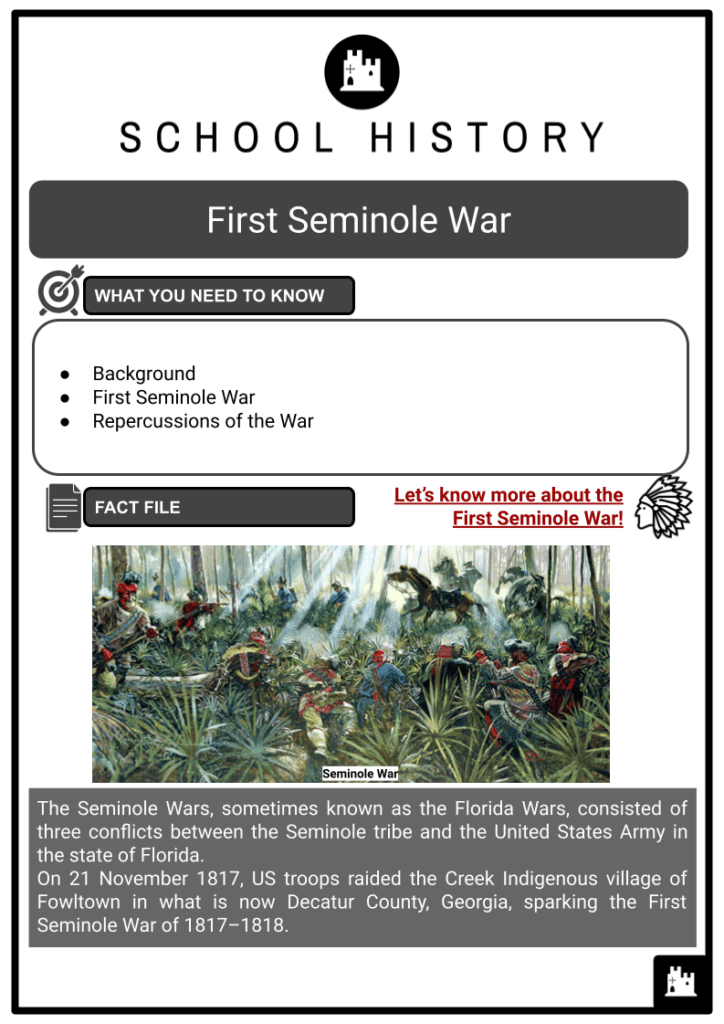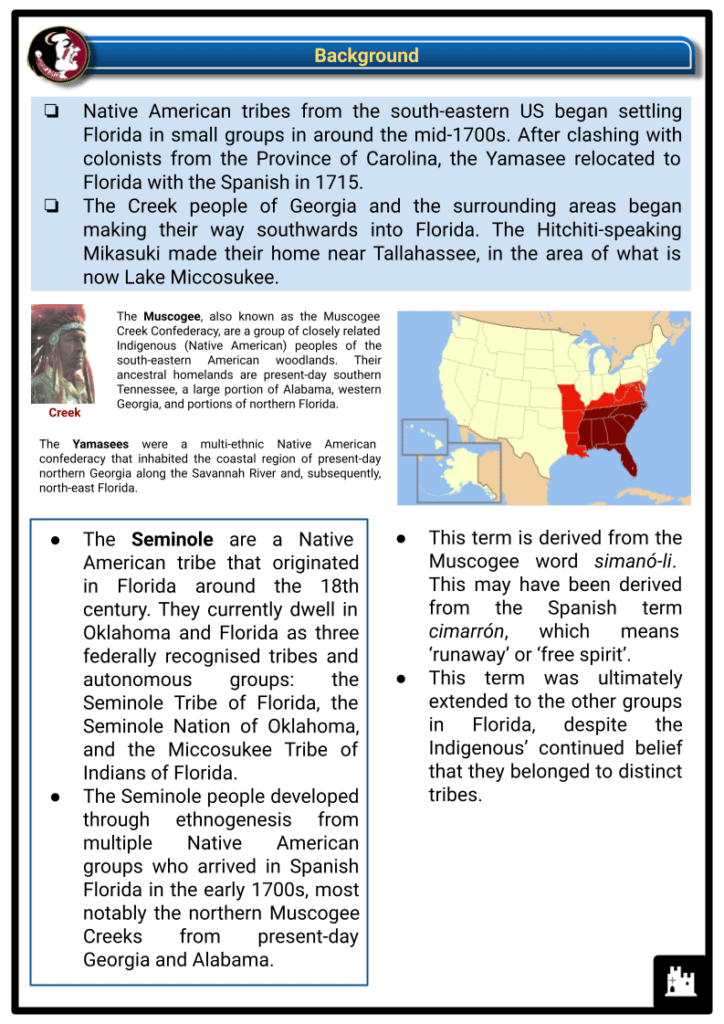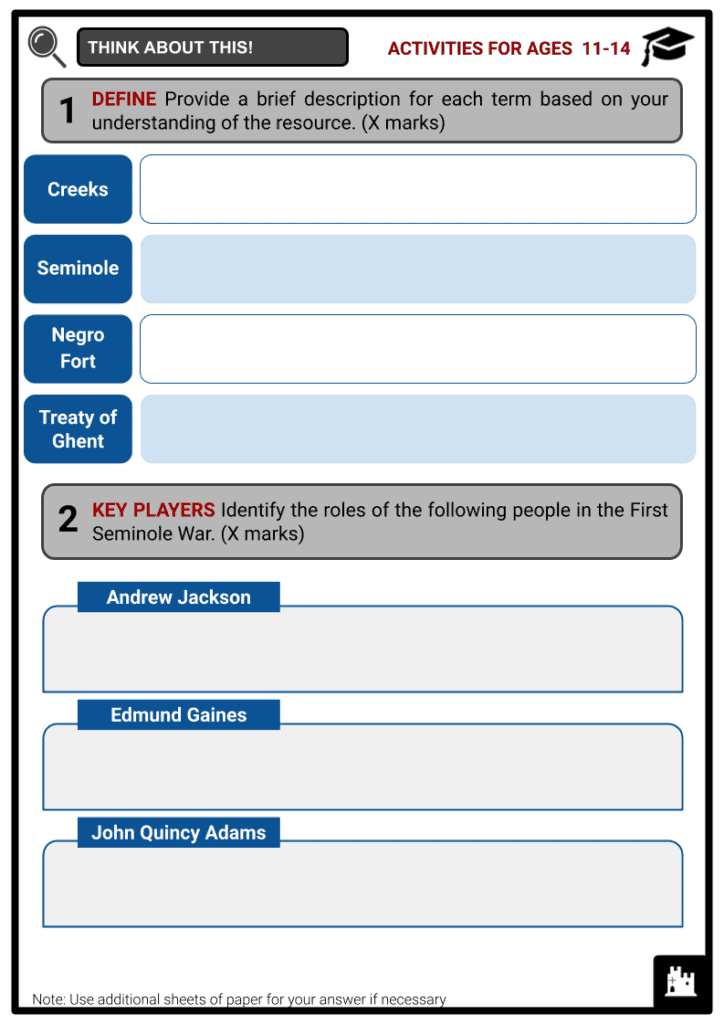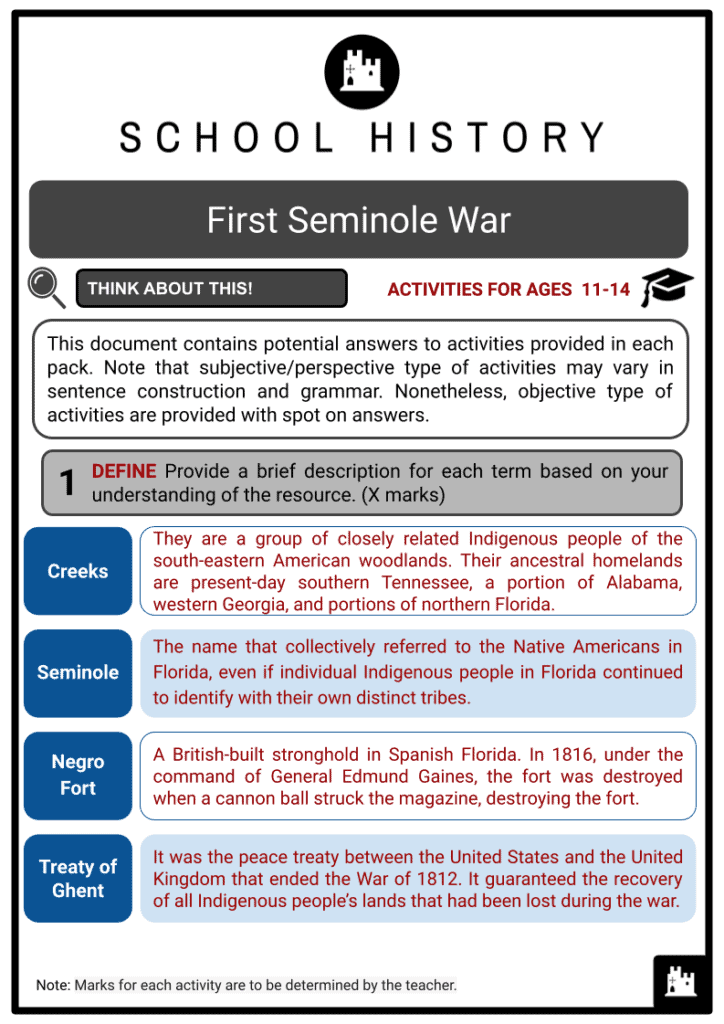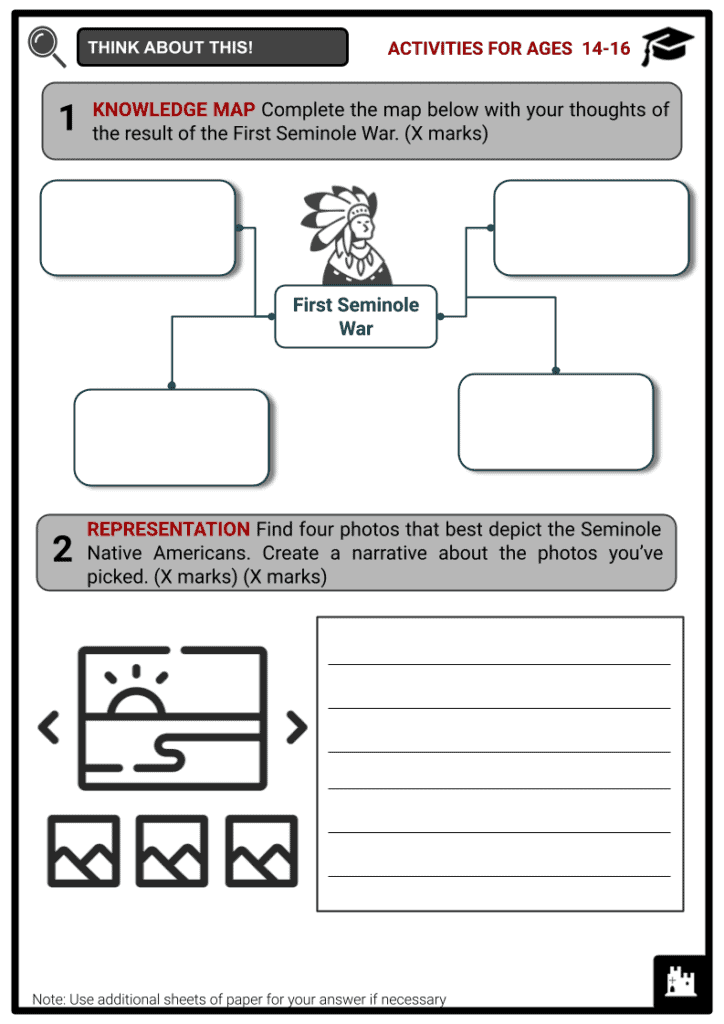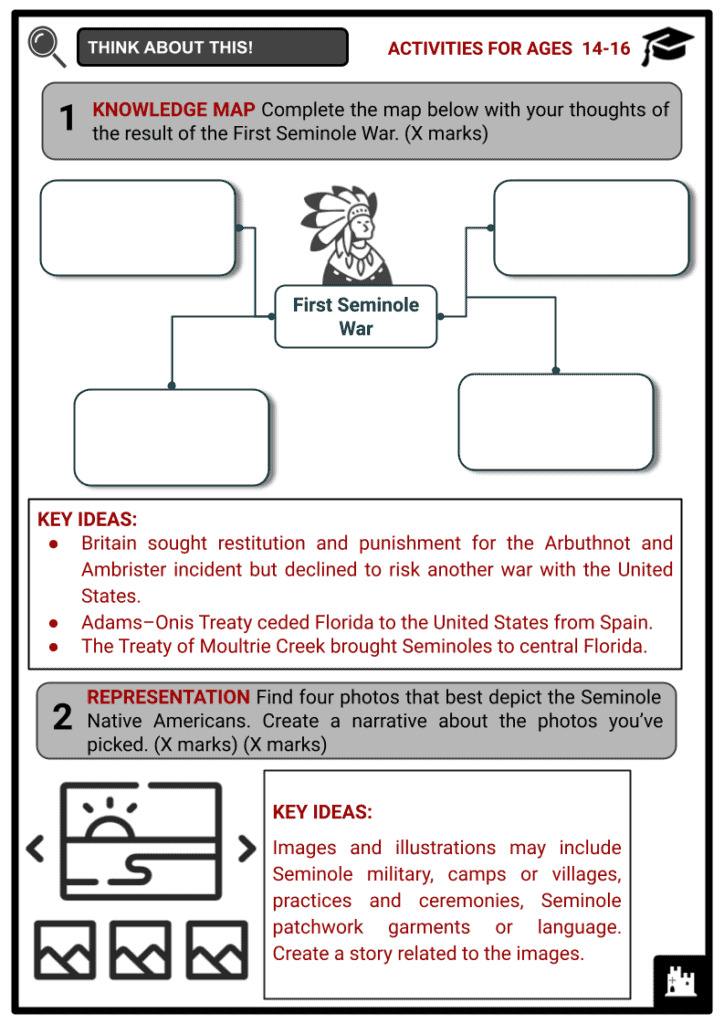First Seminole War Worksheets
Do you want to save dozens of hours in time? Get your evenings and weekends back? Be able to teach about the First Seminole War to your students?
Our worksheet bundle includes a fact file and printable worksheets and student activities. Perfect for both the classroom and homeschooling!
Summary
- Background
- First Seminole War
- Repercussions of the War
Key Facts And Information
Let’s know more about the First Seminole War!
The Seminole Wars, sometimes known as the Florida Wars, consisted of three conflicts between the Seminole tribe and the United States Army in the state of Florida. On 21 November 1817, US troops raided the Creek Indigenous village of Fowltown in what is now Decatur County, Georgia, sparking the First Seminole War of 1817–1818.
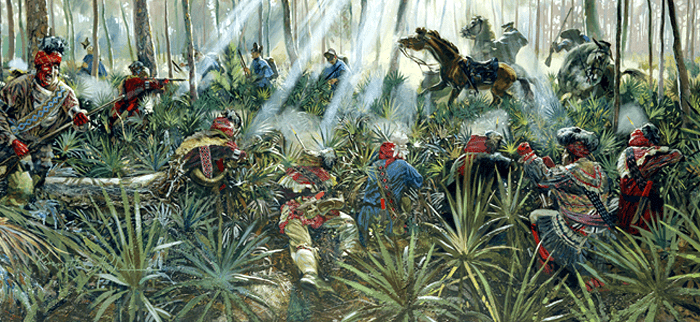
Background
- Native American tribes from the south-eastern US began settling Florida in small groups in around the mid-1700s. After clashing with colonists from the Province of Carolina, the Yamasee relocated to Florida with the Spanish in 1715.
- The Creek people of Georgia and the surrounding areas began making their way southwards into Florida. The Hitchiti-speaking Mikasuki made their home near Tallahassee, in the area of what is now Lake Miccosukee.
- The Muscogee, also known as the Muscogee Creek Confederacy, are a group of closely related Indigenous (Native American) peoples of the south-eastern American woodlands. Their ancestral homelands are present-day southern Tennessee, a large portion of Alabama, western Georgia, and portions of northern Florida.
- The Yamasees were a multi-ethnic Native American confederacy that inhabited the coastal region of present-day northern Georgia along the Savannah River and, subsequently, north-east Florida.
- The Seminole are a Native American tribe that originated in Florida around the 18th century. They currently dwell in Oklahoma and Florida as three federally recognised tribes and autonomous groups: the Seminole Tribe of Florida, the Seminole Nation of Oklahoma, and the Miccosukee Tribe of Indians of Florida.
- The Seminole people developed through ethnogenesis from multiple Native American groups who arrived in Spanish Florida in the early 1700s, most notably the northern Muscogee Creeks from present-day Georgia and Alabama.
- This term is derived from the Muscogee word simanó-li. This may have been derived from the Spanish term cimarrón, which means ‘runaway’ or ‘free spirit’.
- This term was ultimately extended to the other groups in Florida, despite the Indigenous’ continued belief that they belonged to distinct tribes.
- Manuel de Montiano, the Spanish governor of Florida, ordered the construction of Fort Mose and its establishment as a free Black community in 1738. Enslaved African and African-American people who managed to escape and get to the fort were practically set free.
- Many of them were Pensacola natives. Some were free citizens, while others had fled from American soil.
- The enslaved people were given freedom and land in Florida by the Spanish. They enlisted formerly enslaved as militia to help protect Pensacola and Fort Mose. Other runaway enslaved people became free members of Seminole tribes.
- The British, who ruled Florida during the American Revolution (1775–1783), encouraged Seminoles to invade frontier villages in Georgia. The chaos of battle enabled more enslaved people to flee to Florida. The British offered the enslaved their freedom if they fought for them.
- These events turned the new United States into the Seminoles’ enemies. As stated in the Treaty of Paris that ended the American Revolutionary War in 1783, Florida was returned to Spain. Small garrisons were maintained at St Augustine, St Marks and Pensacola, which limited Spain’s control over Florida.
- Spain did not control the boundary between Florida and the United States and was unable to act against the State of Muskogee, which was founded in 1799 as a separate country of Native Americans independent of both the United States and Spain, until 1803 when both governments plotted to entrap its founder.
- Mikasukis and other Seminole tribes continued to occupy villages on the American side of the border, while American squatters went into Spanish Florida.
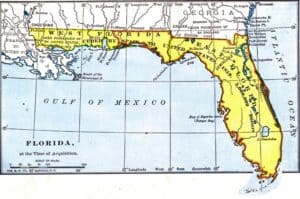
The division of Florida - In 1763, the British separated Florida into East Florida and West Florida. The Spanish maintained this distinction when they reclaimed Florida in 1783. West Florida stretched from the Apalachicola River to the Mississippi River.
- In addition to their dominance of Louisiana, the Spanish had the lower reaches of all rivers draining the United States west of the Appalachians. They barred U.S. transportation and commerce in lower Mississippi.
- In addition to expanding west of the mountains, the United States wanted to acquire Florida. It desired free commerce on western rivers and to prevent Florida from being used as a foothold for a potential European invasion of the United States.
First Seminole War
The Fort
- After defeating the Red Sticks (Upper Creeks people) at the Battle of Horseshoe Bend during the Creek War (1813–1814), Colonel Andrew Jackson rose to national prominence.
- The Battle of Horseshoe Bend took place during the War of 1812 in what is now central Alabama in the Mississippi Territory. On 27 March 1814, under the command of Major General Andrew Jackson, United States forces and Indigenous allies destroyed the Red Sticks, a subtribe of the Creek Indigenous people who opposed American expansion, ultimately ending the Creek War.
- After winning, Jackson coerced the Creek into signing the Treaty of Fort Jackson, which led to the loss of a large portion of Creek territory in what is now southern Georgia and central and southern Alabama.
- As a result, many Creeks migrated to Spanish West Florida. Creek refugees settled and joined the Florida Seminole.
- When the War of 1812 ended, all British forces except Lieutenant Colonel Nicolls and his detachment in Spanish West Florida left the Gulf of Mexico. He was in charge of supplying the fort at Prospect Bluff with cannons, muskets and ammunition. He informed the Indigenous people that the Treaty of Ghent guaranteed the recovery of all Indigenous people’s areas that had been lost during the War of 1812, including the Creek lands in Georgia and Alabama.
- As the Seminoles had no desire to hold a fort, they returned to their settlements. Prior to his departure in the spring of 1815, Nicolls turned over the fort to the runaway enslaved people and Seminoles he had recruited for possible incursions into US territory during the war.
- As rumours of the fort spread throughout the American Southeast, whites began to refer to it as the ‘Negro Fort’. The Americans feared it would encourage their enslaved people to flee to Florida or rebel.
- The end of the War of 1812 in 1815 rendered the fort used to assault the United States unnecessary. When retreating in 1815, the British left the ‘Negro Fort’, together with all its guns and equipment, in the hands of the disciplined, compensated Corps of Colonial Marines Black troops who remained.
- A sizable population of runaway enslaved people, Red Stick Creeks (those who were expelled from the Mississippi Territory and Georgia), and the occasional white merchant lived in its vicinity.
- The establishment of a ‘Negro Fort’, as it was referred to by the United States Army, was abhorrent to Georgia plantation owners, who feared for the safety of their enslaved people. It was a well-known safe haven for fugitive enslaved from Virginia and Tennessee.
- In April 1816, Jackson notified the governor of West Florida, José Masot, that if the Spanish did not remove the fort from Spanish territory, he would.
- Jackson gave command of the fort to Brigadier General Edmund Pendleton Gaines. Gaines gave Colonel Duncan Lamont Clinch the command to construct Fort Scott on the Flint River, just outside of the Florida state line.
- The only feasible method of supplying Fort Scott was by river: a land route would have required traversing wilderness and was not considered. The Apalachicola River was used instead.
- This route meant travelling through Spanish territory and through the ‘Negro Fort’, so the US Army would be able to monitor the Seminole and the ‘Negro Fort’. If the fort opened fire on the supply ships, the Americans would have justification to fire back and destroy it.
- In July of 1816, a Fort Scott supply fleet reached the Apalachicola River. To secure their passage, Clinch assembled a force of more than 100 American soldiers and approximately 150 Lower Creek warriors.
- Clinch met the supply fleet at the ‘Negro Fort’, where two gunboats positioned themselves across the river from the fort. African-Americans in the fort fired their cannons at white American forces and the Creek. The white Americans also fired back.
- The gunboats’ shots landed in the fort’s powder magazine, causing an explosion.
- At least 250 of the 320 known inhabitants of the ‘Negro Fort’, including women and children, died instantly, and many more succumbed to their injuries shortly after. The US Army left Spanish Florida after destroying the fort.
Fowltown and Scott Massacre
- Fowltown was a Mikasuki (Muscogee Creek) settlement in south-western Georgia, located approximately 15 miles (24 kilometres) east of Fort Scott. In a land dispute with Fort Scott’s commander, Mikasuki leader Chief Neamathla of Fowltown claimed authority over the territory on the eastern bank of the Flint River and refused to remove his people from the land.
- The Creeks had surrendered the land in southern Georgia in the Treaty of Fort Jackson, but the Mikasukis did not consider themselves Creek. Therefore, they did not feel obligated by the treaty, which they had not signed, and did not acknowledge the Creeks’ authority to cede Mikasuki property.
- General Gaines dispatched a force of 250 men to capture Fowltown on 21 November 1817. The Mikasukis successfully repelled the initial attack.
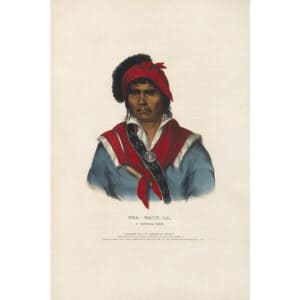
Neamathla Eneah Emathla - The following day, on 22 November 1817, the Mikasukis were expelled from their village. According to some historians, this raid on Fowltown marked the beginning of the First Seminole War.
- A week later, on the Apalachicola River, an attack took place on a supply boat for Fort Scott captained by Lieutenant Richard W Scott. Twenty injured troops, seven spouses, and probably some children made up the majority of the forty to fifty passengers.
- The Indigenous people attacked the boat and slaughtered most of the occupants. Six people made it to the fort, one of whom was a woman, who was captured.
- General Gaines was first ordered not to invade Florida, but eventually opted to permit brief incursions into the state. When news of the Scott Massacre on the Apalachicola reached Washington, Gaines was given orders to invade Florida and pursue the Indigenous people without attacking any Spanish outposts. Gaines had left for East Florida, however, to deal with the pirates who had taken Fernandina.
- John C Calhoun then directed Andrew Jackson to command the invasion of Florida.
East Florida Invasion
- In March 1818, Jackson assembled his forces at Fort Scott, which consisted of 800 US Army regulars, 1,000 Tennessee volunteers, 1,000 Georgia militia and around 1,400 allied Lower Creek warriors (under command of Brigadier General William McIntosh, a Creek chief). Jackson’s army entered Florida on 15 March, moving along the Apalachicola River.
- Jackson had his soldiers build Fort Gadsden when they arrived at the site of the ‘Negro Fort’. The army then marched towards the Mikasuki settlements surrounding Lake Miccosukee.
- The town of Anhaica (present-day Tallahassee) was burned on 31 March 1818 and Miccosukee was seized the next day. Over 300 Indigenous people’s dwellings were destroyed.
- On 6 April 1818, Jackson reached Fort St Marks (San Marcos) after turning south. Jackson conquered the Spanish fort at St Marks.
- After leaving St Marks, Jackson attacked the Suwannee River settlements that were home to runaway enslaved people. On the 12 April, the army launched an attack on a Red Stick settlement near the Econfina River. Nearly 40 Red Stick men and about the same number of women and children were slain and arrested.
- Two British citizens, Alexander Arbuthnot and Robert Ambrister, who were accused of instigating and arming the Indigenous people, were executed.
- Jackson declared victory after destroying the main Seminole and Black Seminole villagers and sent the Georgia troops and Lower Creeks home.
- Jackson returned to Fort Gadsden after leaving the garrison at Fort St Marks.
West Florida Invasion
- General Jackson later reported that the Spanish were gathering and supplying Indigenous people, and on 7 May he departed Fort Gadsden with 1,000 soldiers for Pensacola.
- Jackson did not halt despite protests from the governor of West Florida that the majority of the Indigenous people at Pensacola were women and children and that the men were unarmed. Jackson also indicated that the capture of supplies intended for Fort Crawford was a contributing factor to his decision to march on Pensacola.
- When Jackson arrived in Pensacola on 23 May, the governor and the 175-man Spanish garrison retreated to Fort Barrancas, handing over control of the city to Jackson.
- The two sides exchanged cannon fire for a few days before the Spanish capitulated on 28 May at Fort Barrancas.
- Jackson resigned from his position as military governor of West Florida and returned home.
Repercussions of the War
- Jackson’s actions had international ramifications. John Quincy Adams, Secretary of State, had just begun negotiations with Spain to purchase Florida. Spain denounced the invasion and seizure of West Florida and called off the discussions.
- Because Spain lacked the capacity to retaliate against the US or reclaim West Florida by force, Adams let the Spanish officials protest before issuing a letter asserting that the US was defending its national interests against the British, Spanish and Indigenous people.
- In the letter, Adams also apologised for the seizure of West Florida and said that it was against American policy to take Spanish land, and offered to return St Marks and Pensacola to Spain.
- Spain agreed and eventually resumed the sale of Florida negotiations. Adams demanded Spain either control the residents of East Florida or relinquish it to the United States, defending Jackson’s measures as essential. Following that, a deal was negotiated in which Spain relinquished all claim to West Florida and gave the United States control over East Florida with the Adams–Onis Treaty in 1819, and the United States formally assumed control in 1821.
- Britain objected to the execution of two of its citizens, Arbuthnot and Ambrister, who had never set foot on US soil.
- In Britain, there was talk of seeking restitution and receiving punishment. Due to its failed attempt to conquer the United States during the Conflict of 1812, as well as its desire to preserve its economic interests, Britain ultimately declined to risk another war with the United States.
- Additionally, there were consequences in America. Congressional committees held hearings on the Ambrister and Arbuthnot trials’ anomalies. While the majority of Americans backed Jackson, some were concerned that he may become a ‘man on horseback’, a Napoleon, and turn the country into a military dictatorship.
- Resolutions were submitted condemning Jackson’s actions when Congress reassembled again in December 1818. Jackson’s popularity was too great, and the resolutions were defeated, but the killings of Ambrister and Arbuthnot would forever tarnish his name. Nonetheless, this did not prevent him from becoming president.
Treaty of Moultrie Creek
- The Seminoles remained an issue for the new administration. Capt. John R Bell, interim secretary of the Florida territory and temporary agent to the Seminoles, estimated the number of Indians in Florida at the beginning of 1822. Approximately 22,000 Indigenous people and 5,000 enslaved people were included in his report.
- Indigenous communities were situated around the Apalachicola River, along the Suwannee River, from there south-eastwards to the Alachua Prairie, and then south-westwards to about north of Tampa Bay.
- From the start, the issue with the Seminoles raised concerns among Florida officials. The government made the decision to create a reservation in the heart of the region for the Seminole people in 1823.
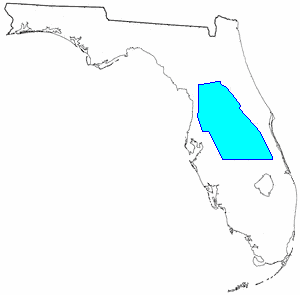
The Treaty of Moultrie Creek established a Seminole reservation in central Florida - The Seminole were compelled to submit to American protection and renounce all claims to territories in Florida under the conditions of the treaty negotiated there in exchange for a reservation of around four million acres.
- The villages along the Apalachicola River belonging to Chief Neamathla and five other chiefs were permitted to remain.
- The US was required to defend the Seminole under the terms of the Treaty of Moultrie Creek as long as they abided by the law. The government was meant to give the Seminole farming tools, cattle and hogs, cover their relocation costs, and feed them for a year while they planted and harvested fresh crops on the reserve.They were also to receive compensation for their travel expenses and other costs associated with moving to the reservation.
- Despite a few isolated incidents of conflict with white people, the Seminoles gradually settled into the reserve.
- Andrew Jackson, a long-time adversary of the Seminoles, was elected president of the United States in 1828. In 1830, the Seminole and other tribes were sent west of the Mississippi River in accordance with the Indian Removal Act, which he had advocated.

